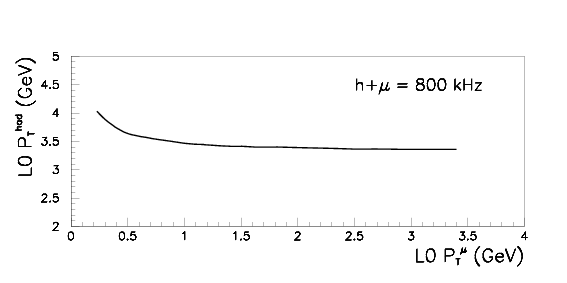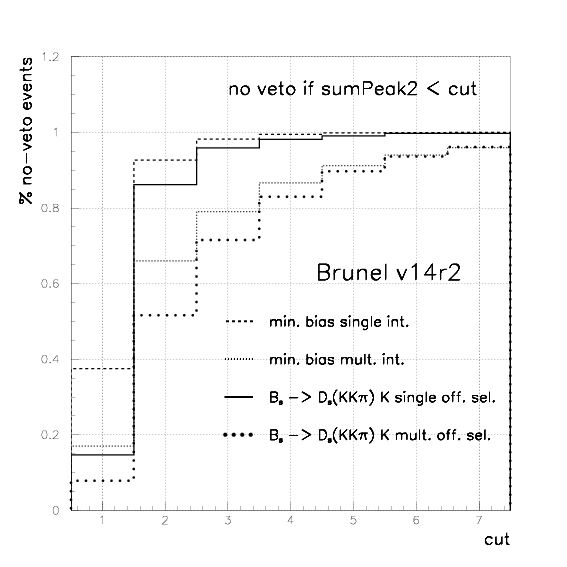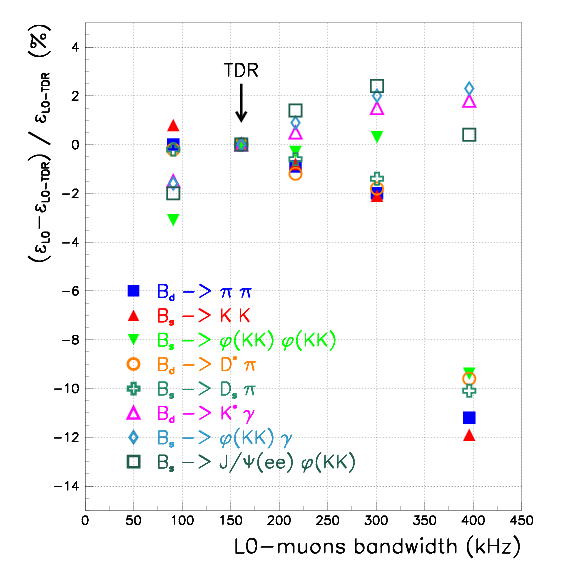

As a consequence of this bandwidth division the L0 thresholds were set to (as of 12/2001)
| L0 Thresholds (GeV) | e | γ | h | ∑ ET | π0L | π0G | μ | ∑ pTμμ |
| 2.712 | 5.006 | 4.469 | 5.00 | 4.10 | 4.60 | 0.795 | 5.024 |


The di-muon trigger is a special trigger in the sense that it is the only allowed (by design) to override the pile-up veto decision, i.e., an event vetoed by the pile-up detector can still be accepted by L0 if and only if the sum of the PT of the 2 highest muons is above a given threshold.
As seen from the previous results on the hadron and muon triggers bandwidth division, the hadronic channels prefer a pile-veto cut at 2 (no pile-up veto if hPeak2 < 2). Cutting at 3 on the hPeak2 variable, the previous efficiency plots suggest that one starts to loose efficiency for the high multiplicity hadronic channels (like Bs → DsK).
The question then arises of whether it is still possible to keep the pile-up veto cut at 2 recuperating the efficency for the Bs → J/Ψ φ channel.
Using the data produced with the Brunel version v14r2, the L0 trigger was re-optimised to maximise for the first time the efficiency on all events - single and multiple interaction events.
The plot below shows the percentage of minimum bias and signal (example of Bs2DsK) events that are not vetoed by the pile-up veto when the height of the second peak is below a certain cut.

It can be seen that by relaxing the cut from 2 (default value used up to now) to 3, the percentage of single (multiple) interaction offline selected events increases from about 86 (52)% to about 95 (71)%.
T he following thresholds correspond to the latest tuning as used to produce the LHCb trigger performance results presented end of January at the LHCC meeting.Note that the pile-up veto decision was taken (for the first time) with a cut on the height of the second peak at 3 (not at 2 as in the past)!
| L0 Thresholds (GeV) | e | γ | h | ∑ ET | π0L | π0G | μ | ∑ pTμμ |
| 2.60 | 3.00 | 3.52 | 5.00 | 4.85 | 4.90 | 1.23 | 1.42 |
The L0 efficiencies (normalised to the offline selected events) were calculated for some available physics channels:
| L0 Efficiencies (%) | true single int. | all interactions |
| Bd → K+ π- | 69 | 61 |
| Bd → K* γ | 89 | 77 |
| Bd → π+ π- | 67 | 61 |
| Bs0 → Ds-(K+ K- π-) K+ | 49 | 45 |
| Bs0 → Ds-(K+ K- π-) π+ | 48 | 46 |
| Bs0 → J/Ψ(e+ e-) φ(K+ K-) | 50 | 46 |
| Bs0 → J/Ψ(μ+ μ-) φ(K+ K-) | 90 | 91 |
| Bs → K+ K- | 63 | 57 |
The talk "L0 Bandwidth Division with Multiple Interaction Events " presenting the details of the work can be found here.
This tuning on multiple interaction events was the one used to calculate all the L0 trigger efficiencies presented in the LHCC document of end January 2003.
Purpose of the study: to study the L0-muon Bandwidth, in case LHCb should decide to drop the M1 muon station.
The impact of the removal of M1 can be studied for non-muon channels by looking at the hadron/electromagnetic channel efficiency as a function of the bandwidth allocated to the muons. At the moment we have about 160kHz of inclusive muons. With the removal of M1 the muons bandwidth will tend to increase ... what is the effect of going up to, say, 300 kHz? Such an impact can be translated in terms of a fractional loss plot as a function of the bandwidth allocated to the muon triggers for some of our benchmark channels without muons, such as:
Bd → π+ π-
Bs → K+ K-
Bs → φ(K+ K-) φ(K+ K-)
Bd → D* π
Bs → Ds-(K+ K- π-) π+
Bd → K* γ
Bs → φ(K+ K-) γ
Bs → J/Ψ(e+ e-) φ(K+ K-)
Four settings were used to roughly cover a L0-muon bandwidth in the range 100-300 kHz. The results were then compared to the reference as in the Trigger System TDR.
Throughout the studies all the electromagnetic settings were kept constant and as in the Trigger System TDR.
| L0 Thresholds (GeV) | h | μ | ∑ pTμμ |
| set 1 | 4.30 | 0.30 | 0.50 |
| set 2 | 3.80 | 0.50 | 0.70 |
| set 3 | 3.70 | 0.80 | 1.00 |
| TDR | 3.60 | 1.10 | 1.30 |
| set4 | 3.50 | 1.80 | 2.10 |
These sets of settings give the following inclusive rates:
| Inclusive rates (kHz) | h | μ | ∑ pTμμ |
| set 1 | 401 | 294 | 322 |
| 396 | |||
| set 2 | 593 | 217 | 257 |
| 301 | |||
| set 3 | 658 | 155 | 184 |
| 217 | |||
| TDR | 705 | 110 | 145 |
| 161 | |||
| set4 | 772 | 60 | 81 |
| 91 | |||
Note that these sets of settings give a hadronic+muons inclusive rate of about 840 kHz (except of a rate ~ 760 for set 1).

There has been some interest in studying the performance of LHCb if we were to run at a higher average luminosity than the nominal L = 2 x 1032cm-2s-1. I here propose a set of L0 settings that could be used for high luminosities such as 3 x 1032 and 5 x 1032cm-2s-1.
In retuning the thresholds the bandwidth division was kept roughly the same as for the nominal conditions. And all the global event selection cuts were left with their default values.
L0 thresholds for running at an average luminosity of
L = 3 x 1032cm-2s-1:
At such a luminosity the L0 minimum-bias retention rate goes down from the nominal 6.7% to about 5.2%
in order to still keep a L0 output rate of 1 MHz.
| L0 Thresholds (GeV) | h | e | γ | π0L | π0G | μ | ∑ pTμμ |
| 3.90 | 2.90 | 2.60 | 4.50 | 4.00 | 1.80 | 2.50 |
L0 thresholds for running at an average luminosity of
L = 5 x 1032cm-2s-1:
At this luminosity the L0 minimum-bias retention rate is only 4.1%.
| L0 Thresholds (GeV) | h | e | γ | π0L | π0G | μ | ∑ pTμμ |
| 4.20 | 3.00 | 2.80 | 4.80 | 4.40 | 2.50 | 4.00 |
Options files are available here to run L0 with the settings described above for the 2 luminosities:
These options files replace the standard L0.opts file of DaVinci for running over these high-luminosity samples.
|
|